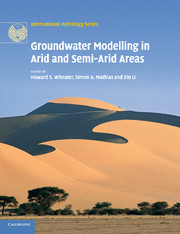Book contents
- Frontmatter
- Contents
- Contributors
- Preface
- Acknowledgements
- 1 Groundwater modelling in arid and semi-arid areas: an introduction
- 2 Hydrological processes, groundwater recharge and surface-water/groundwater interactions in arid and semi-arid areas
- 3 Conceptual models for recharge sequences in arid and semi-arid regions using isotopic and geochemical methods
- 4 Groundwater flow and transport
- 5 Performing unbiased groundwater modelling: application of the theory of regionalised variables
- 6 Groundwater vulnerability and protection
- 7 Variable density groundwater flow: from modelling to applications
- 8 Sustainable water management in arid and semi-arid regions
- Index
- Plate section
- References
1 - Groundwater modelling in arid and semi-arid areas: an introduction
Published online by Cambridge University Press: 06 December 2010
- Frontmatter
- Contents
- Contributors
- Preface
- Acknowledgements
- 1 Groundwater modelling in arid and semi-arid areas: an introduction
- 2 Hydrological processes, groundwater recharge and surface-water/groundwater interactions in arid and semi-arid areas
- 3 Conceptual models for recharge sequences in arid and semi-arid regions using isotopic and geochemical methods
- 4 Groundwater flow and transport
- 5 Performing unbiased groundwater modelling: application of the theory of regionalised variables
- 6 Groundwater vulnerability and protection
- 7 Variable density groundwater flow: from modelling to applications
- 8 Sustainable water management in arid and semi-arid regions
- Index
- Plate section
- References
Summary
INTRODUCTION
Water resources globally face unprecedented challenges, but these are at their greatest in the world's arid and semi-arid regions. Recent IPCC estimates (Kundzewicz et al., 2007) state that between 1.4 and 2.1 billion people live in areas of water stress; those numbers are expected to increase significantly under the pressures of population growth and climate change.
By definition, arid and semi-arid regions have limited natural water resources, and precipitation and runoff have very high variability in space and time. Traditional societies recognised these characteristics and developed sustainable water management solutions. In higher rainfall areas, for example in the mountains of northern Yemen and Greek islands such as Cephalonia, rainwater was harvested from roofs and paved surfaces and stored for household or community use. In desert areas, such as Arabia's ‘empty quarter’, with infrequent, spatially localised rainfall, nomadic communities would follow rainfall occurrence, using water from surface storage or shallow groundwater for a few months to support themselves and their livestock, before moving on. For agriculture, terraced systems were developed to focus infiltration to provide soil moisture for crop water needs (as in the mountains of Northern Oman and Yemen), and earth dams were built to divert flash floods onto agricultural land for surface irrigation (as in South West Saudi Arabia). In parts of the Middle East, groundwater was extracted sustainably using qanats (Iran) or afalaj (Oman), ancient systems of tunnels for gravity drainage of groundwater, developed over centuries or longer.
- Type
- Chapter
- Information
- Publisher: Cambridge University PressPrint publication year: 2010
References
- 1
- Cited by



